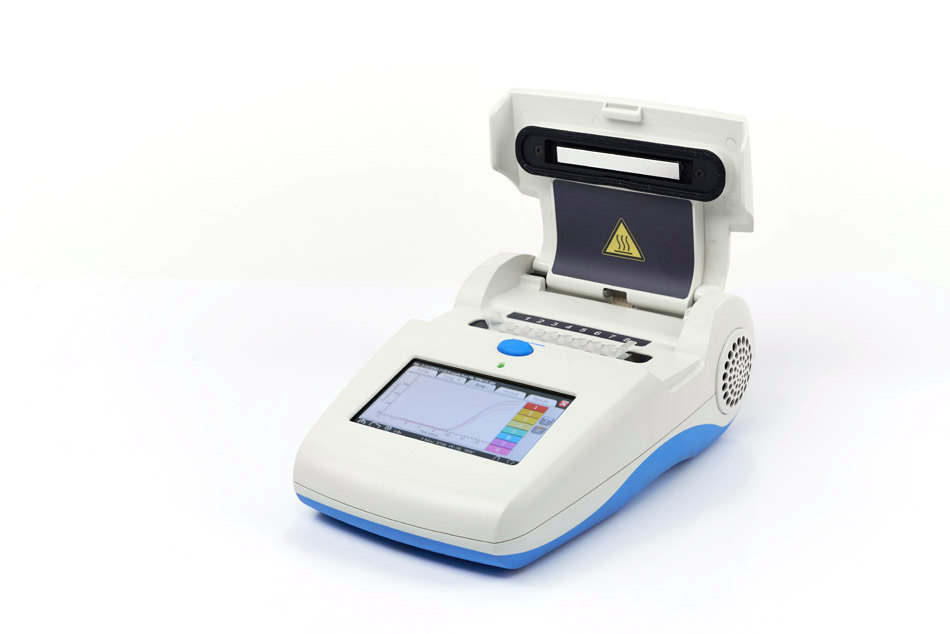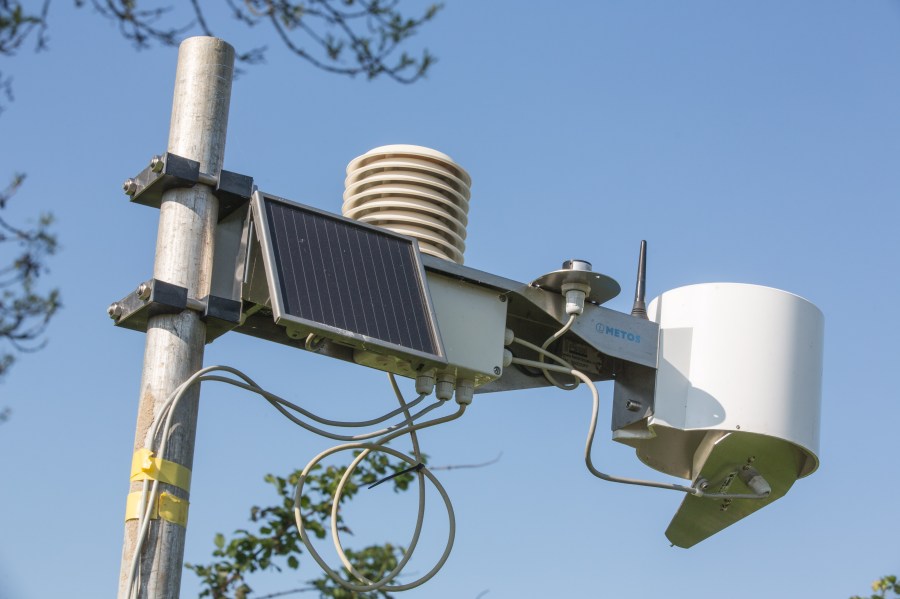Technology is moving at a break-neck pace and is set to help improve the timing of fungicide applications. CPM learns more about new developments in in-field diagnostics and the secrets they can reveal.
The big problem many growers face is not knowing whether they’re in a protectant or curative situation.
By Lucy de la Pasture
For wheat growers, the latent phase of septoria has always created a challenge when it comes to septoria control. It represents a time when the septoria pathogen has infected leaves but none of the tell-tale symptoms of infection are visible, explains Bayer’s Jennifer Watson. That means it’s a best guess as to whether fungicide is being applied in a truly preventative or a curative situation.
Although septoria modelling has been well developed and septoria risk data has been available for several years, the use made of this forecasting information has been limited. But it’s about to take a quantum leap in its helpfulness to agronomists, thanks to the development of some nifty in-field diagnostics.
New LAMP (Loop mediated isothermal amplification) technology is being utilised in Bayer research at Fera and is investigating the latency of septoria. The work has now completed a second season.

The Genie III device that makes in-field LAMP diagnostics possible.
“The idea behind the study is to help understand more about septoria, and its latent phase in particular. It also looks at how technology might be employed to give more accurate prediction tools,” says Jennifer.
“The big problem many growers face is not knowing whether they’re in a protectant or curative situation at the T2 timing. Hopefully this work will aid decision making and help deliver more effective disease control strategies.”
In its first season, the research revealed the value of varietal resistance as a management tool. DNA testing of leaf two, just prior to T2, revealed big differences in septoria DNA concentrations between different wheat varieties – KWS Trinity (AHDB Recommended List rating of 5.7 for septoria), Revelation (RL 6.3) and KWS Siskin (RL 6.9). Some Trinity samples had DNA contents 20 times higher than KWS Siskin.
Last season varietal differences were recorded again, but only really revealed themselves when wetter weather arrived in May, explains Jennifer, adding varietal resilience can add an extra ten days to a fungicide spray window.
“Clearly this will vary from season to season and is dependent on drilling dates, winter weather and rain events ahead of key growth stages. DNA levels in KWS Siskin at ten days post-GS39 were still below that of KWS Trinity just prior to GS39,” she highlights.
In 2017, the acceleration of build-up of septoria DNA surprised Bayer and Fera experts, with the study revealing just how quickly the disease situation can change, explains Jennifer.
“In some areas the spring was a dry one, with early spring rainfall just 10% of the expected amount, and this checked septoria development. But wet weather around the middle of May had a profound effect, completely changing the risk level where septoria was concerned.

The development of an in-field test for septoria means agronomists and growers could be getting results within 20mins of analysis being undertaken, says Neil Boonham.
“In leaf-two tests taken at Callow on 26 May, we recorded very low levels of septoria DNA – nothing above 2000 picograms. But by June it had soared, with samples taken on 9 June revealing levels between 6000 – 10,000 pg. It just shows you how quickly the threat can change,” she explains.
This rapid acceleration in levels of septoria DNA reflects the rapid growth of the pathogen and is why growers can be taken unawares by the disease. What were once healthy green leaves were suddenly overcome with septoria. If the May rain had arrived a few weeks earlier, growers expecting a protective situation at T2 could have found the opposite.
“The latent phase of septoria can be as long as 28 days, and starts when the fungus has penetrated the leaf. By the time it starts growing inside the leaf you’re past the period of peak fungicide effectiveness,” says Jennifer, adding that’s why timing is so important.
“Septoria doesn’t go away in dry spells – it just sits there waiting for the weather to trigger it again. The flag leaf needs protection as soon as it’s fully emerged, because the optimum time for control is at the start of the latent phase. Although leaves may look green, once mycelia start to spread in the leaf then it’s too late to control effectively. Ascra (prothioconazole+ bixafen+ fluopyram) is one of the most effective fungicides, but even this will never fully eradicate septoria in a curative situation.”
Fungicide application in a curative situation is something Jennifer is keen to avoid. To help achieve this she stresses the importance of an effective T1 in reducing disease levels ahead of T2 sprays. “It’s an important part of resistance management. The ideal is to still be in a protective situation ahead of flag leaf applications.”
CropMonitor data shows that although septoria incidence didn’t match that of 2012 or 2014, the weather in May last season put the disease on a par with the 2001 – 2010 average.
“As growers start to turn their attention to fungicide inputs this season, it might be worth noting Bayer trial results from last year. Data from five sites (28 varieties) showed a mean 3.0 t/ha yield response to a standard fungicide programme of Aviator (prothioconazole+ bixafen) at T1 and Ascra at T2,” she points out.
Since making sure fungicides are timed ahead of infection is such an important part of a resistance management strategy, part of the Fera research remit was to evaluate the possibility of in-field testing for septoria to help aid fungicide decision making.
The in-field DNA amplification technology, LAMP, developed at Fera, has been tested for accuracy against the gold standard of quantitative PCR testing, and according to Fera’s Dr Neil Boonham, the results are encouraging.
“The test is certainly very accurate and close to that of qPCR. It was our first year of field work and further testing is needed, but in a few years from now the in-field test means agronomists and growers could be getting results within 20 mins of analysis being undertaken.”
He acknowledges that in-field LAMP testing on its own isn’t enough to accurately predict septoria severity, but when combined with new spore-trapping technology, weather and latent-disease modelling, it could give a highly detailed picture of a developing septoria threat.
Alongside further testing of portable DNA amplification equipment, Fera will be placing new Spore Sentry spore monitors at several Bayer demo sites. The spore monitors use a cyclone system, similar to that found in Dyson vacuum cleaners, to collect spores daily and measure inoculum levels using LAMP technology, and also record local weather data.
“This will tell us spore concentrations and the most conducive periods for infection. It’s ‘realtime’ field information to improve decision making,” he says. “That’s something that’s all important when it comes to best practice and safeguarding chemistry.
“More detailed information will help us target actives and rates more accurately at the disease threat the crop is facing. Greater precision in fungicide strategies will eliminate unnecessary chemistry being applied and help safeguard current actives,” he says.
CHAP to help with smart decisions
A Smart Decision Support Unit will be one of the first services rolled out by the Agritech Centre for Crop Health and Protection (CHAP). Fera’s plant pathology science lead Dr Judith Turner explains that the LAMP devices used in the septoria latency work and new automated spore traps will be sending diagnostic information back to Fera from a number of sites across the UK in 2018.
“The Decision Support Unit has a network of over 30 sites in total which are monitoring pests and diseases in wheat, barley, oilseed rape and potato crops. This information will be combined with local weather station data to run bespoke models providing a prediction of risk for pests and diseases in the different crops,” she explains.
This information will be accessible to all via a free web-service, with national and regional information for the wheat crop going live towards the end of March (www.cropmonitor.co.uk).
“The free service will enable growers to access risk forecasts for all the pests and diseases to the wheat crop within a single system. The more locally detailed forecasting will include information necessary to help guide decision making in the field and will be available in spring 2019 as a subscription-based service,” she explains.
These more bespoke forecasts will include predictions of risk of spore release, prediction and/or detection of latent infection in crops, prediction of infection risk and identification of spray windows; all delivered in a time-frame to support decision-makers on whether to spray, optimal spray timing, product choice and dose (dependent on level of risk and variety).
“The Smart Decision Support Unit will be partnering with the CHAP’s Resistance and Virulence Management Unit, looking at the characteristics of pathogen populations in terms of their fungicide resistance and virulence, and will help provide growers with a fuller picture to help with fungicide decisions in the field.”
“The launch of the free wheat crop service this spring will be followed a phased release of forecasts for the pests and diseases affecting OSR, which is hoped to be fully complete for the autumn,” adds Judith.
Early PGR best bet in spring barley
Many spring barley crops lodged badly last harvest, particularly in the Midlands. There’s no doubt 2017 was a particularly tricky season, with a very dry period early in the crops life, followed by rain in the nick of time to save the crop but at a time where late PGR applications were either impossible or ineffective.
The biggest danger growers can make is to farm their spring barley crops based on last year’s season, points out Agrovista’s Chris Martin, technical manager in the North and Scotland.
“Last year, the crop’s nitrogen regime was dictated by the weather. Crops became stressed early on and then got their nitrogen late in the day, all in one hit after the rain came. That produced crops that very quickly became lush and leggy, with brackling also a problem due to the surge of growth late in the season. This bounce-back effect can also be seen in a more normal season where early PGRs are used.”
Many crops were considered under too much stress last spring to receive any early PGR, in line with their label recommendations. Later timings with Terpal (2-chloroethylphosphonic acid+ mepiquat chloride) are often practically difficult to achieve because ear emergence is so fast, explains Chris.
“In hindsight, an application of 0.25 – 0.5 l/ha Canopy (mepiquat chloride+ prohexadione-calcium), particularly where crops had muck underneath them, would have been the kindest of the PGRs under stress conditions. It would have helped hold crops back after the rain and any bounce-back effect tends to be less than where chlormequat is applied,” he says.
One of the problems Chris highlights is the use of high seed rates where spring barley is being grown to combat blackgrass. “Most of the spring barley varieties have reasonably good lodging rating but in Agrovista trials, Irena stood out for standing power where it was sown at the higher seed rate of 450 seeds/m2.
“To be honest, more work needs to be done on spring barley agronomy. Most of the research was carried out in the 1980s and isn’t relevant to the high yielding crops of today,” he concludes.




